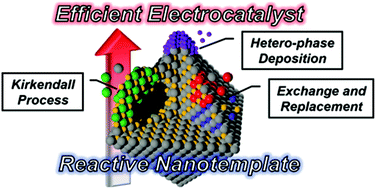Reactive nanotemplates for synthesis of highly efficient electrocatalysts: beyond simple morphology transfer
Abstract
Efficient electrocatalysts for energy conversion in general, and fuel cell operation and water electrolysis in particular, are pivotal for carbon-free hydrogen production. While the requirements of successful electrocatalysts include a high number density of catalytically active sites, high surface-to-volume ratio, inherently high catalytic activity, and robustness of the catalyst surface structure under harsh operating conditions, it is extremely difficult to synthesize nanocatalysts that could possess all these structural characteristics. Nanotemplate-mediated synthesis, namely, the coating or filling of a template with a desired material phase followed by the removal of the template, has captured the interest of researchers because of the ease of creating hollow-structured nanocatalysts with a high surface to volume ratio. Recent studies, however, have revealed that nanotemplates could be more than just passive supports because they greatly affect catalytic performance by creating an unusual synergy between the substrate and catalyst and by providing dopants to the actual catalyst phase owing to their reactive nature. In this review, we discuss the most notable recent advances in the nanotemplate-based synthesis of electrocatalysts as well as the unusual effects of nanotemplates on the performance of nanocatalysts. We also provide an outlook for this fledgling field so that future research efforts could be focused on the development of practically useful electrocatalysts that could shape the future of energy technologies.

- This article is part of the themed collection: Nanoscale 10th Anniversary Special Issue


 Please wait while we load your content...
Please wait while we load your content...